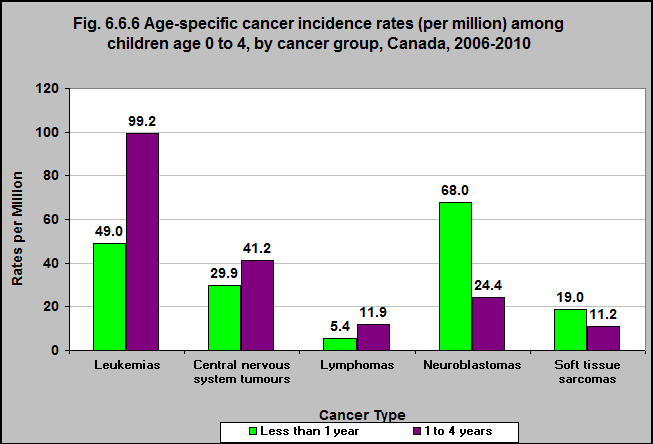Age-specific cancer incidence rates (per million) among children age 0 to 4, by cancer group, Canada, 2006-2010

Source: CICH graphic created using data adapted from Ellison, L., and Janz, T. Statistics Canada, Canadian Cancer Registry (last modified in 2015). http://www.statcan.gc.ca/pub/82-624-x/2015001/article/14213-eng.htm – accessed March 8th, 2017.
During the time period 2006-2010, neuroblastomas were the most common kinds of cancer in infants less than 1 year old.
During the time period 2006-2010, leukemias were the most common kinds of cancer among children aged 1 to 4 years.
Leukemias, central nervous system tumours, lymphomas, neuroblastomas and soft tissue sarcomas accounted for 68% of all cancers among infants under a year and 80% of all cancers among 1 to 4 year-olds.
Related Studies
In meta-analyses of studies linking parents, prenatal and childhood exposure to leukemia have shown associations between pesticide exposure and childhood leukemia in both residential and occupational settings.1
In addition, recent studies have shown a link between children’s exposure to air pollutants and leukemia.1
Studies also indicated that childhood, parental and prenatal exposure to pesticides may lead to brain tumors in children.1
Evidence also suggests that exposure to environmental tobacco smoke – prenatal and postnatal – is linked to childhood brain tumors.1
Many studies have looked at the association between cellular phone use and brain cancer – the findings are not yet conclusive.1
A number of review studies have found associations between parental, prenatal and childhood exposures to pesticides and childhood lymphomas.1
There is also evidence linking prenatal and postnatal exposure to environmental tobacco smoke and childhood lymphomas.1
1Environmental Protection Agency. Children’s Health and the Environment Third Edition. 2013. https://www.epa.gov/sites/production/files/2015-06/documents/ace3_2013.pdf – accessed May 22, 2017
